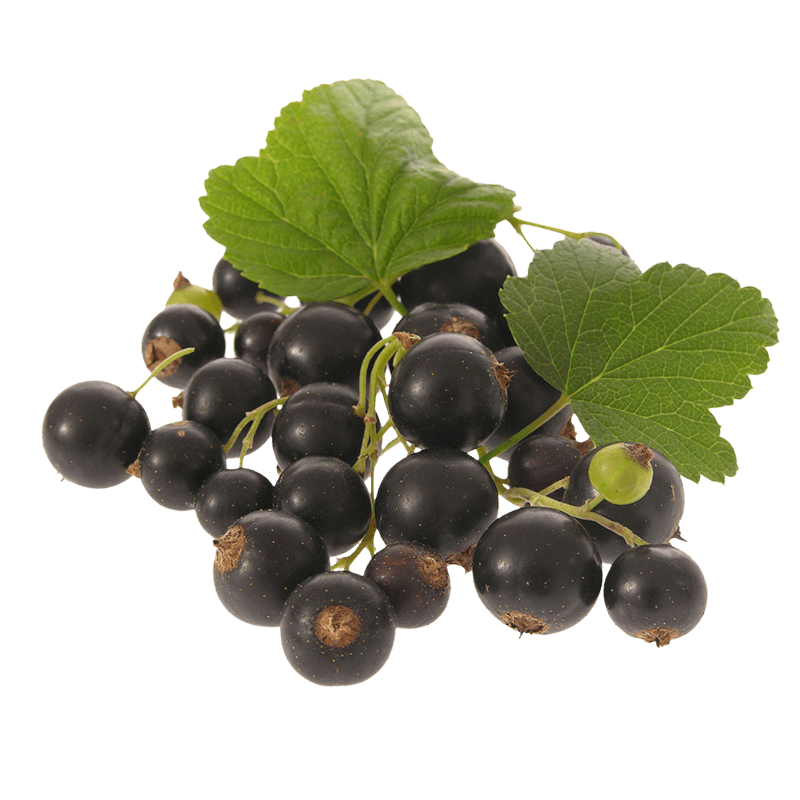
Blackcurrant
Latin name
Origin
Used part
Active components
Flavonoids and phenolic components: antioxidant action.
Proanthocyanidins: anti-inflammatory action.
Vitamin C: Antioxidant action.
Essential oil: responsible for its diuretic action.
Usage
Bibliographical references
- Assessment report on Ribes nigrum L., folium
Committee on Herbal Medicinal Products
EMA/HMPC/1http://www.ema.europa.eu/docs/en_GB/document_library/Herbal_-_HMPC_assessment_report/2010/07/WC500094204.pdf42989/2009; 6 May 2010
European Medicines Agency: - [Flavonoids extracted from Ribes nigrum L. and Alchemilla vulgaris L.: 1. In vitro inhibitory activities on elastase, trypsin and chymotrypsin. 2. Angioprotective activities compared in vivo].
Jonadet M, Meunier MT, Villie F, Bastide JP, Lamaison JL.
J Pharmacol. 1986 Jan-Mar;17(1):21-7.
Pubmed: http://www.ncbi.nlm.nih.gov/pubmed/3635653 - Anti-inflammatory evaluation of a hydroalcoholic extract of black currant leaves (Ribes nigrum).
Declume C.
J Ethnopharmacol. 1989 Nov;27(1-2):91-8.
Pubmed: http://www.ncbi.nlm.nih.gov/pubmed/2615431 - Proanthocyanidins, from Ribes nigrum leaves, reduce endothelial adhesion molecules ICAM-1 and VCAM-1.
J Inflamm (Lond). 2005 Aug 9;2:9.
Garbacki N, Kinet M, Nusgens B, Desmecht D, Damas J.
Pubmed: http://www.ncbi.nlm.nih.gov/pubmed/16091140 - Inhibitory effects of proanthocyanidins from Ribes nigrum leaves on carrageenin acute inflammatory reactions induced in rats.
Garbacki N, Tits M, Angenot L, Damas J.
BMC Pharmacol. 2004 Oct 21;4:25.
Pubmed: http://www.ncbi.nlm.nih.gov/pubmed/15498105 - Effects of prodelphinidins isolated from Ribes nigrum on chondrocyte metabolism and COX activity.
Garbacki N, Angenot L, Bassleer C, Damas J, Tits M.
Naunyn Schmiedebergs Arch Pharmacol. 2002 Jun;365(6):434-41.
Pubmed: http://www.ncbi.nlm.nih.gov/pubmed/12070756 - Plant Extracts from Meristematic Tissues (Foliar Buds And Shoots): Antioxidant And Therapeutic Action
Andreea Militaru, Ioana Simedrea, Iren Alexoi, Camelia Peev, Elena Bernad, Claudia Toma Studia Universitatis Vasile Goldis: http://www.studiauniversitatis.ro/v15/pdf/20-2010/20-3-2010/SU20-3-10Militaru.pdf - Chemical and biological studies of Ribes nigrum L. buds essential oil.
Oprea E, Radulescu V, Balotescu C, Lazar V, Bucur M, Mladin P, Farcasanu IC.
Biofactors. 2008;34(1):3-12.
Pubmed: http://www.ncbi.nlm.nih.gov/pubmed/19706967 - Composition of the essential oils of black currant buds (Ribes nigrum L.)
Jean Luc Le Quere, Alain Latrasse
J. Agric. Food Chem. 1990, 38, 3-10
ACS Publication: http://pubs.acs.org/doi/abs/10.1021/jf00091a001
The health claims that feature on our website in relation to the plants contained in our products are compliant with the list of health claims awaiting final assessment by the Community authorities (cf. website of the European Commission: http://ec.europa.eu/nuhclaims/). However, they may be subject to modification following their assessment by the national competent authorities.
The health claims relating to other nutrients or substances contained in our products that feature on our site are compliant with Regulation No. 432/2012 of the Commission of 16 May 2012 which establishes a list of authorised health claims authorised in relation to food products, other than those in reference to the reduction of the risk of disease as well as community-based development and child health (cf. website of the European Commission: http://ec.europa.eu/nuhclaims/).

 Belgique
Belgique  België
België  France
France  Italia
Italia  Portugal
Portugal  España
España  United Kingdom
United Kingdom  Κύπρος
Κύπρος 